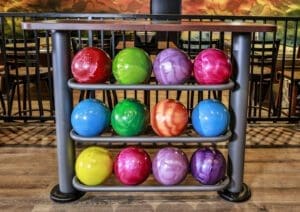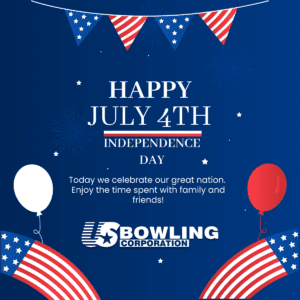Wondering just how to choose a bowling ball?
We’re here to help you understand the bowling terms you need to know, and the factors to consider when choosing a bowling ball.
There are 6 major factors to consider when shopping for a bowling ball
1. Weight: The weight of the ball should be comfortable for you to throw with good control.
The weight of a bowling ball can vary, but most bowling balls are between 12 and 16 pounds. The most commonly used ball weight is 14 pounds.
The weight of a bowling ball is measured in pounds and ounces, and the standard weight range is between 6 and 16 pounds. The weight of a bowling ball is usually determined by the bowler’s strength and personal preference.
For adult men and women, a weight between 14 to 16 pounds is a good starting point. For children and lighter individuals, a ball weight of 12 to 14 pounds is recommended.
It’s important to note that it is always best to use a ball that is comfortable for you to throw with good control, and that you should not sacrifice control for extra power. Also, when picking up a bowling ball make sure to check if the ball is comfortable for you to hold, and if you can control it well.
2.  Hook potential: If you’re looking to hook the ball more, you’ll want to choose a ball with a higher hook potential.
Hook potential: If you’re looking to hook the ball more, you’ll want to choose a ball with a higher hook potential.
Hook potential refers to a bowling ball’s ability to hook, or change direction, as it travels down the lane. A ball with a high hook potential will tend to hook more and change direction more, while a ball with a low hook potential will tend to skid more and have less hook.
The hook potential of a ball is primarily determined by the coverstock and drilling. Coverstocks such as urethane and reactive resin tend to have higher hook potential, while plastic coverstocks tend to have lower hook potential. The drilling of the ball, which includes the layout and the position of the holes, also affect the hook potential of the ball.
A ball with higher hook potential is generally considered better for experienced bowlers who want more control over the direction of the ball and want to be able to create more angles on the lane. While lower hook potential balls are generally considered better for bowlers who want more predictability and less hook.
3. Coverstock: The coverstock of the ball affects its reaction on the lanes. Urethane and reactive resin coverstocks tend to hook more, while plastic coverstocks tend to skid more.
The coverstock of a bowling ball is the outer layer of material that covers the ball’s core. It is the part of the ball that comes in contact with the lanes and affects the ball’s reaction, or how it moves on the lane.
There are several different types of coverstocks:
- Urethane: Urethane coverstocks are considered to be the most versatile and provide good hook potential. They are also very durable and tend to last longer than other coverstocks.
- Reactive resin: Reactive resin coverstocks are similar to urethane coverstocks in that they provide good hook potential, but they tend to be more sensitive to oil and can create more angular reactions on the lane.
- Particle: Particle coverstocks are made of small, hard particles suspended in a matrix of resin. They have high hook potential and are known to produce very angular reactions on the lane, making them a great choice for experienced bowlers who want more control over their shots.
- Plastic: Plastic coverstocks are the most basic type of coverstock, they tend to have low hook potential and are known for their predictability and skid reaction on the lane, making them a great choice for beginner bowlers.
The type of coverstock you choose will depend on your individual playing style, skill level, and the type of lanes you will be bowling on.
4. Drilling: The drilling of the ball can affect its hook potential and reaction on the lanes. Consult with a professional to determine the best drilling for your ball.
The drilling of a bowling ball refers to the layout and position of the holes in the ball, which can affect the ball’s hook potential, reaction on the lane, and overall performance.
There are several different types of drilling layouts, including:
- Finger: Finger drilling is the most common layout and is used for all types of bowlers. The holes are drilled to fit the bowler’s fingers.
- Thumb: Thumb drilling is used for bowlers who use a thumb hole in their ball.
- Two-handed: Two-handed drilling is used for bowlers who use two hands to throw the ball.
The position of the holes can also affect the ball’s reaction on the lane. For example, a ball with the holes drilled near the fingers will have more hook potential than a ball with the holes drilled near the thumb.
Consulting with a professional or pro-shop is the best way to determine the best drilling for you. They will take into consideration your throwing style, skill level, and what you are trying to achieve with your ball reaction. They may also suggest drilling patterns that may not be common but will provide the best result for you.
NOTE: drilling is not permanent and can be redone or adjusted as your skill level or playing style changes.
Yes, it is possible to fill the holes in a bowling ball and redrill them to a different layout or position. This process is called “plugging” and it’s done by a professional at a pro-shop using a special plugging tool and epoxy. Once the holes have been filled, the ball can be redrilled to the desired layout and position.
It’s a good idea to consult with a professional or pro-shop before making any decisions about plugging your ball. They will be able to advise you on whether it’s worth the cost and effort, and will also be able to properly plug and redrill the ball for you.
5. Cost and your Budget: When buying a bowling ball, it’s important to choose one that suits your individual playing style and skill level, rather than simply going for the most expensive option.
The cost of a good bowling ball can vary widely depending on a number of factors, such as the brand, model, coverstock, and drilling. On average, a high-quality bowling ball can cost anywhere from $100 to $300 or more.
A good entry-level bowling ball can cost around $100 to $150, these balls are usually made of plastic coverstock and lower hook potential, making them suitable for beginner bowlers.
Mid-range bowling balls can cost around $150 to $200. These balls are made of a combination of materials such as reactive resin and urethane and have medium hook potential, making them suitable for intermediate bowlers.
High-end bowling balls can cost $200 to $300 or more. These balls are usually made of reactive resin coverstock and have a high hook potential, making them suitable for experienced bowlers.
It’s also worth noting that some of the most advanced and high-tech balls can cost more than $300. The price of a bowling ball can also depend on the added features like reactive pearl or hybrid coverstocks, asymmetrical cores and other technologies that can enhance its performance.
The most expensive bowling balls can cost several thousand dollars, depending on the brand and technology used. Some of the most advanced and high-tech bowling balls on the market can have a price tag of $1000 or more.
These balls are usually made with the most advanced materials and technologies available, such as reactive pearl or hybrid coverstocks, asymmetrical cores, and other features that enhance performance. Some of the most expensive bowling balls are also custom-made to order and are tailored to the individual needs and preferences of the customer.
However, it’s important to note that the price of a bowling ball does not necessarily indicate its quality or performance. A more expensive ball may have features that are not suitable for your skill level or playing style.
6. Personal preference: Ultimately, the best ball for you is one that you feel comfortable throwing and that suits your individual playing style.



